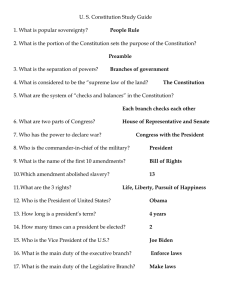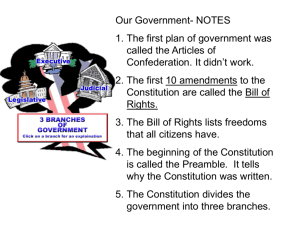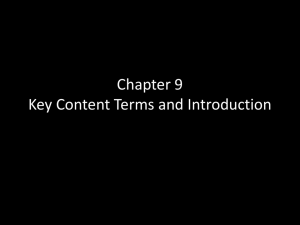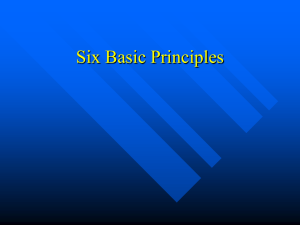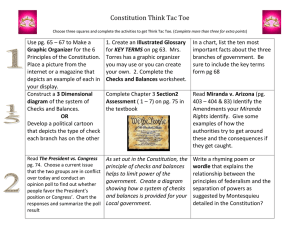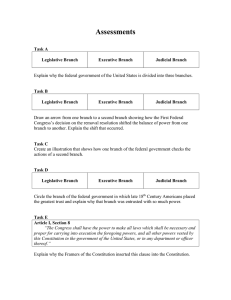Principles of the Constitution
advertisement
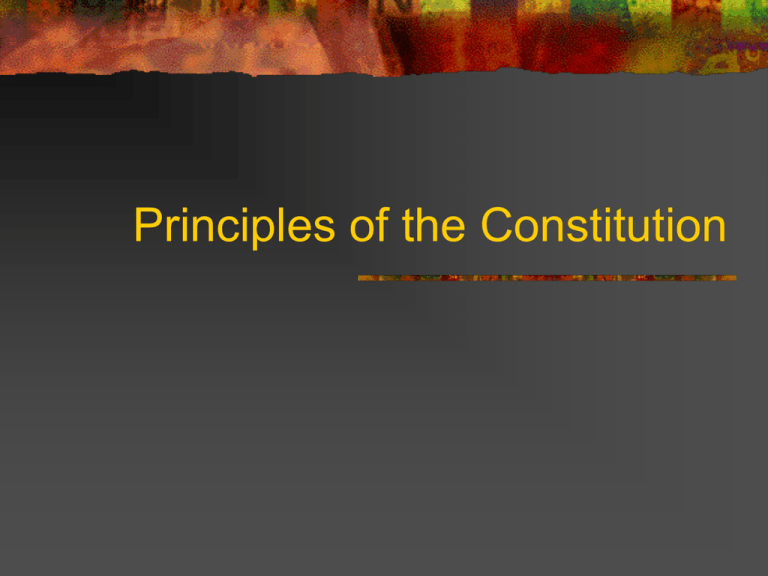
Principles of the Constitution Separation of Powers To Madison, tyranny was gov’t that controlled all three branches (argument for division of power) This diffuses power instead of concentrating it Danger of one branch combining forces with another (argument for checks and balances) Need for strong executive Checks and Balances Fear of tyranny; distrust of government; meant to build inefficiency to prevent gov’t abuse of power 18th century view of gov’t restraint combined with modern view of gov’t use for common good Each branch has check on other two Ex.: veto, appointment, veto override, treaty making, judicial review, commander-in-chief, law making Political Independence (no branch is dependent on other two) Staggering Terms (2yr, 6 yr., life appointment) Modifications of Checks and Balances Political Parties: Theory: parties should bring branches together Reality: Parties are weakened by wide range of interests Divided Gov’t: President of one party: Congress of the other Changes in Voting Methods: Congressmen chosen by people; President chosen by electors who vote with people. Growth of Federal Bureaucracy: Development of numerous agencies with legislative, executive, judicial functions (Ex. IRS, Justice Dept. , EPA, etc. ) Modifications (Cont’d) Changes in technology: Two Views 1) President, Congress, Interest Groups, and Media take advantage of new technology (strengthens checks/balances) 2) Presidents takes advantage through “staged events” (Ex.:Bush’s Mission Accomplished, Obama’s Acceptance Speech in Grant Park)); (weakens checks/balances) 3) Emergence of U.S. as Superpower: U.S. is leader of free world with interests around the world that require us to respond to many crisis (Responsibilities concentrate power in executive branch) “IMPERIAL PRESIDENCY” Limited Government Dillema: Wanting more effective gov’t, but limited gov’t to avoid tyranny Remedy: 1) Constitutional Gov’t- Only powers listed in Constitution 2) Bill of Rights: Safeguard against strong, distant federal government (10th Amendment) 3) Free Elections (Potential of majority faction; Madison cautioned against this) Judicial review Power of Courts to strike down law Not explicitly provided in Constitution; but Constitution open to interpretation Marbury v. Madison (1803) Effect: Litigation has become a way of making public policy (Brown v. Board of Ed. Striking down separate, but equal or Gideon v. Wainwright; right to counsel) Changing the Constitution (Formal; Adding Amendments) Proposal 2/3 vote from both Houses. No Presidential veto possible Constitutional Convention Called by Congress (At request of 2/3 of states) Never Used Formal Changes (Cont’d) Ratification (2 Methods) ¾ of State Legislatures -All, but one done this way (21st Amendment) -Most state legislatures ratify with simple majority Ratifying Conventions in ¾ of states - Amendment 21 done this way Changing the Constitution (informal) Principle: Constitution is a framework Informal ways counteract difficulty in changing Const. Acts of Congress (Voting Rights Act, 1965) Judicial Rulings (Brown v. Board, Gideon v. Wainwright) Presidential Action (Executive Order, e.g. Japanese Internment) Customs/Traditions (Cabinet, Parties, Committees) “Constitution belongs to the living, not the dead” - Jefferson Jefferson believed each generation might need a new Constitution Has not occurred due to the use of informal changes which have allowed Constitution to adapt to changing times

